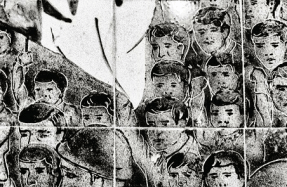The Ballad of Nan Goldin

Nan Goldin moved from Boston in 1978 to Manhattan’s Lower East Side. She was twenty-five years old. New Wave was starting to happen, and so was she. Nan went everywhere with her camera. She was part of the Times Square Show in 1980, on her way, it would turn out, to the Whitney Biennial in 1985 and beyond. She was creating The Ballad of Sexual Dependency (1983–2008) as a slideshow during this time, when the underground, of which she was a star, suddenly riveted the attention of a larger culture. This new youth vanguard was urban and music-driven, as into film as it was into books.
Stylistically, The Ballad of Sexual Dependency claimed descent from Weimar (the echo of a song title from The Threepenny Opera in Nan’s title is deliberate), from the women as well as the men of the Beat generation, and from Andy Warhol. But the toughness was a front. Nan’s early images survive a time of sexual life before AIDS and a love of drugs before the wages of addiction had to be paid. Nan is the witness of a passing American innocence, watching her community as it became decimated by AIDS.
The Ballad of Sexual Dependency was first published as a book in 1986. Its more than one hundred photographs show the drive of Nan’s aesthetic—her intimacy with her subjects, her decision not to photograph anyone doing something she herself would not be willing to be photographed doing, her theatrical sense of place, her mastery of visual narrative. The Ballad of Sexual Dependency is a story about love and desire, loneliness and friendship, men and women. The people we see are her friends, her lovers, and the family she had made for herself. Nan has called it “the diary I let people read.” It is a work that evolved as a slideshow from performance to performance. The installation of The Ballad of Sexual Dependency exhibited at the Museum of Modern Art, New York, in the 2016–17 season featured 690 images.
“It was photography as the sublimation of sex,” Nan wrote in 2017, “a means of seduction, and a way to remain a crucial part of my subjects’ lives.” Her story goes a long way toward explaining her work, seen in numerous books. The Other Side (1993), an homage, in part, to drag, followed The Ballad of Sexual Dependency. Then came A Double Life (1994) and the catalog of her spectacular retrospective at the Whitney Museum of American Art, I’ll Be Your Mirror (1996). The Devil’s Playground (2003) encompassed much of her new work at the time. The Beautiful Smile (2007) marked the occasion of Nan receiving the Hasselblad Award. Eden and After (2014) is a touching work about childhood. In Diving for Pearls (2016), Nan engages with art in the collection of the Louvre through her photography. Her work constitutes an autobiography in several volumes, her life as an episodic tale.
The range of subjects, the sheer amount of published photographs, speaks of Nan being always at work, immersed in her purpose to document the movement of a life. Just as her subjects have changed, so has her practice. Her projects, such as Sisters, Saints, and Sibyls (2004) and Memory Lost (2019), take to an unprecedented level the slideshow form she has made her own. Her unique, unforgettable installations have been exhibited in museums and galleries throughout the world. Nan is one of the most critically acclaimed and inspiring photographers working today. The courage she has shown in her work is fueled by a social bravery that makes her formidable as an activist for marginal communities. Luc Sante once called Goldin a “portraitist of souls.”
New York’s Lower East Side, Berlin, Naples, London, Bangkok, Tokyo, Paris—she’s laid
You’re reading a preview, subscribe to read more.
Start your free 30 days





